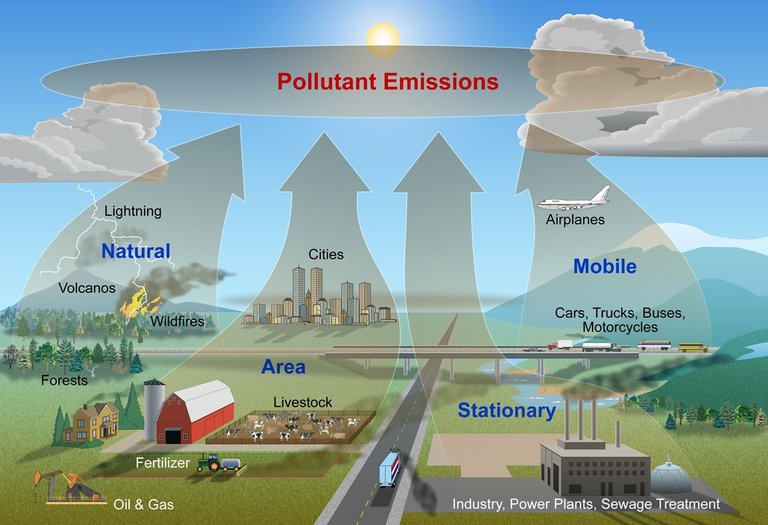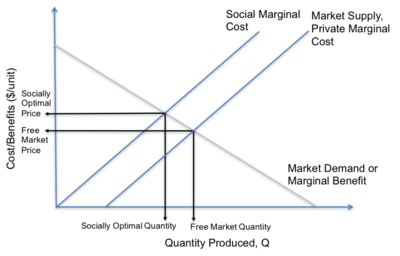
Pollution is the introduction of contaminants into the natural environment that cause adverse change.[1] Pollution can take the form of chemical substances or energy, such as noise, heat or light. Pollutants, the components of pollution, can be either foreign substances/energies or naturally occurring contaminants. Pollution is often classed as point source or nonpoint source pollution. In 2015, pollution killed 9 million people in the world.[2][3]
Major forms of pollution include: Air pollution, light pollution, littering, noise pollution, plastic pollution, soil contamination, radioactive contamination, thermal pollution, visual pollution, water pollution.
Forms of pollution
The Lachine Canal in Montreal, Quebec, Canada.
Blue drain and yellow fish symbol used by the UK Environment Agency to raise awareness of the ecological impacts of contaminating surface drainage.
The major forms of pollution are listed below along with the particular contaminant relevant to each of them:
Air pollution: the release of chemicals and particulates into the atmosphere. Common gaseous pollutants include carbon monoxide, sulfur dioxide, chlorofluorocarbons (CFCs) and nitrogen oxides produced by industry and motor vehicles. Photochemical ozone and smog are created as nitrogen oxides and hydrocarbons react to sunlight. Particulate matter, or fine dust is characterized by their micrometre size PM10 to PM2.5.
Light pollution: includes light trespass, over-illumination and astronomical interference.
Littering: the criminal throwing of inappropriate man-made objects, unremoved, onto public and private properties.
Noise pollution: which encompasses roadway noise, aircraft noise, industrial noise as well as high-intensity sonar.
Plastic pollution: involves the accumulation of plastic products and microplastics in the environment that adversely affects wildlife, wildlife habitat, or humans.
Soil contamination occurs when chemicals are released by spill or underground leakage. Among the most significant soil contaminants are hydrocarbons, heavy metals, MTBE,[22] herbicides, pesticides and chlorinated hydrocarbons.
Radioactive contamination, resulting from 20th century activities in atomic physics, such as nuclear power generation and nuclear weapons research, manufacture and deployment. (See alpha emitters and actinides in the environment.)
Thermal pollution, is a temperature change in natural water bodies caused by human influence, such as use of water as coolant in a power plant.
Visual pollution, which can refer to the presence of overhead power lines, motorway billboards, scarred landforms (as from strip mining), open storage of trash, municipal solid waste or space debris.
Water pollution, by the discharge of wastewater from commercial and industrial waste (intentionally or through spills) into surface waters; discharges of untreated domestic sewage, and chemical contaminants, such as chlorine, from treated sewage; release of waste and contaminants into surface runoff flowing to surface waters (including urban runoff and agricultural runoff, which may contain chemical fertilizers and pesticides; also including human feces from open defecation - still a major problem in many developing countries); groundwater pollution from waste disposal and leaching into the ground, including from pit latrines and septic tanks; eutrophication and littering.
Pollutants
Main article: Pollutant
A pollutant is a waste material that pollutes air, water, or soil. Three factors determine the severity of a pollutant: its chemical nature, the concentration and the persistence.
Cost of pollution
Pollution has a cost.[23][24][25] Manufacturing activities that cause air pollution impose health and clean-up costs on the whole of society, whereas the neighbors of an individual who chooses to fire-proof his home may benefit from a reduced risk of a fire spreading to their own homes. A manufacturing activity that causes air pollution is an example of a negative externality in production. A negative externality in production occurs “when a firm’s production reduces the well-being of others who are not compensated by the firm."[26] For example, if a laundry firm exists near a polluting steel manufacturing firm, there will be increased costs for the laundry firm because of the dirt and smoke produced by the steel manufacturing firm.[27] If external costs exist, such as those created by pollution, the manufacturer will choose to produce more of the product than would be produced if the manufacturer were required to pay all associated environmental costs. Because responsibility or consequence for self-directed action lies partly outside the self, an element of externalization is involved. If there are external benefits, such as in public safety, less of the good may be produced than would be the case if the producer were to receive payment for the external benefits to others. However, goods and services that involve negative externalities in production, such as those that produce pollution, tend to be over-produced and underpriced since the externality is not being priced into the market.[26]
Pollution can also create costs for the firms producing the pollution. Sometimes firms choose, or are forced by regulation, to reduce the amount of pollution that they are producing. The associated costs of doing this are called abatement costs, or marginal abatement costs if measured by each additional unit.[28] In 2005 pollution abatement capital expenditures and operating costs in the US amounted to nearly $27 billion.[29]
Socially optimal level of pollution
Society derives some indirect utility from pollution, otherwise there would be no incentive to pollute. This utility comes from the consumption of goods and services that create pollution. Therefore, it is important that policymakers attempt to balance these indirect benefits with the costs of pollution in order to achieve an efficient outcome.[30]
A visual comparison of the free market and socially optimal outcomes.
It is possible to use environmental economics to determine which level of pollution is deemed the social optimum. For economists, pollution is an “external cost and occurs only when one or more individuals suffer a loss of welfare,” however, there exists a socially optimal level of pollution at which welfare is maximized.[31] This is because consumers derive utility from the good or service manufactured, which will outweigh the social cost of pollution until a certain point. At this point the damage of one extra unit of pollution to society, the marginal cost of pollution, is exactly equal to the marginal benefit of consuming one more unit of the good or service.[32]
In markets with pollution, or other negative externalities in production, the free market equilibrium will not account for the costs of pollution on society. If the social costs of pollution are higher than the private costs incurred by the firm, then the true supply curve will be higher. The point at which the social marginal cost and market demand intersect gives the socially optimal level of pollution. At this point, the quantity will be lower and the price will be higher in comparison to the free market equilibrium.[32] Therefore, the free market outcome could be considered a market failure because it “does not maximize efficiency”.[26]
This model can be used as a basis to evaluate different methods of internalizing the externality. Some examples include tariffs, a carbon tax and cap and trade systems.
Pollution has a cost.[23][24][25] Manufacturing activities that cause air pollution impose health and clean-up costs on the whole of society, whereas the neighbors of an individual who chooses to fire-proof his home may benefit from a reduced risk of a fire spreading to their own homes. A manufacturing activity that causes air pollution is an example of a negative externality in production. A negative externality in production occurs “when a firm’s production reduces the well-being of others who are not compensated by the firm."[26] For example, if a laundry firm exists near a polluting steel manufacturing firm, there will be increased costs for the laundry firm because of the dirt and smoke produced by the steel manufacturing firm.[27] If external costs exist, such as those created by pollution, the manufacturer will choose to produce more of the product than would be produced if the manufacturer were required to pay all associated environmental costs. Because responsibility or consequence for self-directed action lies partly outside the self, an element of externalization is involved. If there are external benefits, such as in public safety, less of the good may be produced than would be the case if the producer were to receive payment for the external benefits to others. However, goods and services that involve negative externalities in production, such as those that produce pollution, tend to be over-produced and under priced since the externality is not being priced into the market.[26]

Pollution can also create costs for the firms producing the pollution. Sometimes firms choose, or are forced by regulation, to reduce the amount of pollution that they are producing. The associated costs of doing this are called abatement costs, or marginal abatement costs if measured by each additional unit.[28] In 2005 pollution abatement capital expenditures and operating costs in the US amounted to nearly $27 billion.[29]
Source
Plagiarism is the copying & pasting of others work without giving credit to the original author or artist. Plagiarized posts are considered spam.
Spam is discouraged by the community, and may result in action from the cheetah bot.
More information and tips on sharing content.
If you believe this comment is in error, please contact us in #disputes on Discord
Hi! I am a robot. I just upvoted you! I found similar content that readers might be interested in:
http://qa.answers.com/Q/What_is_pollution